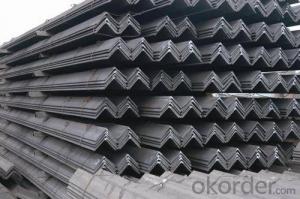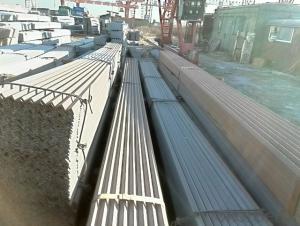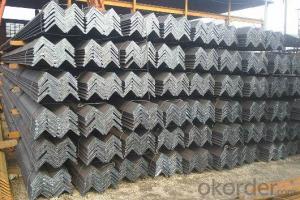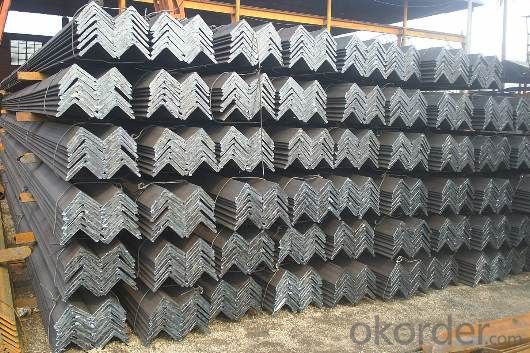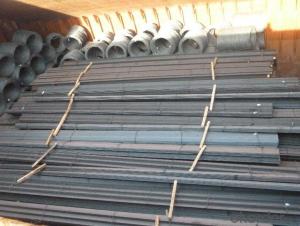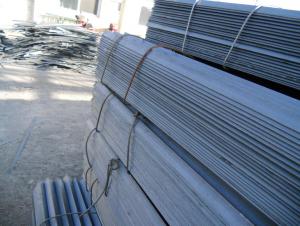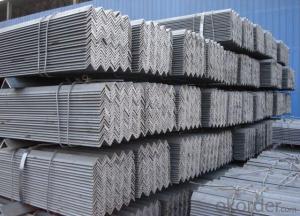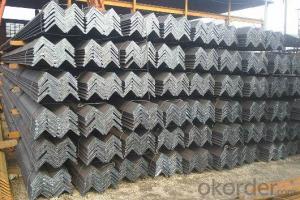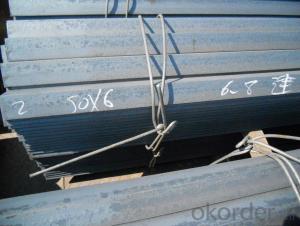Hot Rolled Steel Angles with High Quality
- Loading Port:
- Tianjin
- Payment Terms:
- TT OR LC
- Min Order Qty:
- 25 m.t.
- Supply Capability:
- 20000 m.t./month
OKorder Service Pledge
OKorder Financial Service
You Might Also Like
Product Description:
OKorder is offering high quality Steel Angle Bar at great prices with worldwide shipping. Our supplier is a world-class manufacturer of steel, with our products utilized the world over. OKorder annually supplies products to European, North American and Asian markets. We provide quotations within 24 hours of receiving an inquiry and guarantee competitive prices.
Product Applications:
Steel Angle Bars are ideal for structural applications and are widely used in the construction of buildings and bridges, and the manufacturing, petrochemical, and transportation industries.
Product Advantages:
OKorder's Steel Angle bars are durable, strong, and resist corrosion.
Main Product Features:
· Premium quality
· Prompt delivery & seaworthy packing (30 days after receiving deposit)
· Corrosion resistance
· Can be recycled and reused
· Mill test certification
· Professional Service
· Competitive pricing
Product Specifications:
Manufacture: Hot rolled
Grade: Q195 – 235
Certificates: ISO, SGS, BV, CIQ
Length: 6m – 12m, as per customer request
Packaging: Export packing, nude packing, bundled
Sizes: 25mm-250mm | ||
a*t | ||
25*2.5-4.0 | 70*6.0-9.0 | 130*9.0-15 |
30*2.5-6.6 | 75*6.0-9.0 | 140*10-14 |
36*3.0-5.0 | 80*5.0-10 | 150*10-20 |
38*2.3-6.0 | 90*7.0-10 | 160*10-16 |
40*3.0-5.0 | 100*6.0-12 | 175*12-15 |
45*4.0-6.0 | 110*8.0-10 | 180*12-18 |
50*4.0-6.0 | 120*6.0-15 | 200*14-25 |
60*4.0-8.0 | 125*8.0-14 | 250*25 |
FAQ:
Q1: Why buy Materials & Equipment from OKorder.com?
A1: All products offered byOKorder.com are carefully selected from China's most reliable manufacturing enterprises. Through its ISO certifications, OKorder.com adheres to the highest standards and a commitment to supply chain safety and customer satisfaction.
Q2: What makes stainless steel stainless?
A2: Stainless steel must contain at least 10.5 % chromium. It is this element that reacts with the oxygen in the air to form a complex chrome-oxide surface layer that is invisible but strong enough to prevent further oxygen from "staining" (rusting) the surface. Higher levels of chromium and the addition of other alloying elements such as nickel and molybdenum enhance this surface layer and improve the corrosion resistance of the stainless material.
Q3: Can stainless steel rust?
A3: Stainless does not "rust" as you think of regular steel rusting with a red oxide on the surface that flakes off. If you see red rust it is probably due to some iron particles that have contaminated the surface of the stainless steel and it is these iron particles that are rusting. Look at the source of the rusting and see if you can remove it from the surface.
Images:
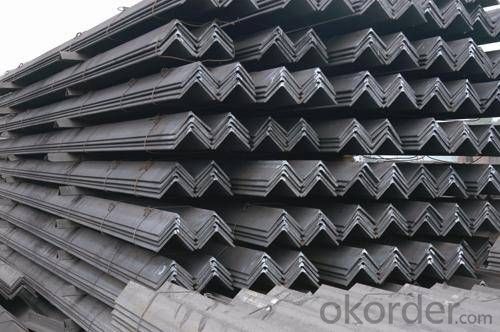
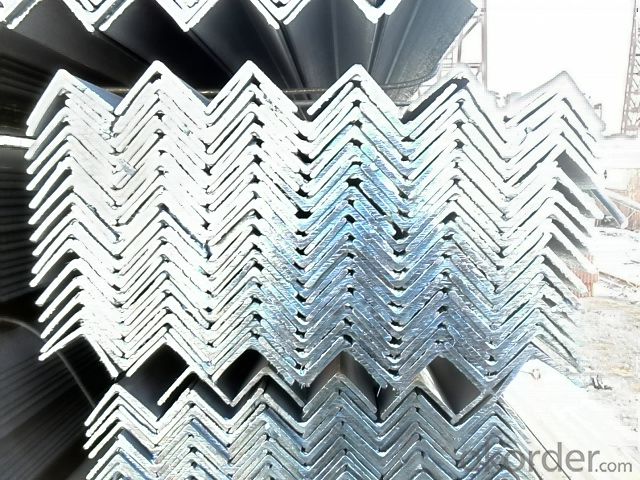

- Q: What are the common finishes available for steel angles?
- There are several common finishes available for steel angles, depending on the desired aesthetic appeal and level of protection required. Some of the most common finishes include: 1. Mill finish: This is the most basic and untreated finish, which is achieved by leaving the steel angle in its natural state after the manufacturing process. It has a rough, gray appearance and provides minimal corrosion resistance. 2. Hot-dip galvanized: This finish involves immersing the steel angle in a bath of molten zinc, which creates a protective coating on the surface. Hot-dip galvanizing provides excellent corrosion resistance and is commonly used in outdoor applications where the angle will be exposed to harsh environments. 3. Powder coating: This finish involves applying a dry powder to the steel angle, which is then heated and cured to create a durable and decorative coating. Powder coating provides a wide range of colors and textures and offers good corrosion resistance. 4. Painted finish: Steel angles can also be painted using various types of paint, including epoxy, enamel, or acrylic-based coatings. Painting provides a decorative finish and can also offer some degree of corrosion resistance, depending on the type and quality of the paint used. 5. Stainless steel: Steel angles made from stainless steel offer a distinct finish that is resistant to corrosion, staining, and rust. Stainless steel angles are often used in applications where hygiene, aesthetics, and longevity are important, such as in the food processing and medical industries. It's important to consider the specific requirements of your project, including the environment and intended use of the steel angle, when choosing the appropriate finish. Consulting with a steel supplier or expert can help you determine the best finish for your needs.
- Q: Can steel angles be used for temporary structures or scaffolding?
- Certainly, temporary structures or scaffolding can make use of steel angles. Because of their strength and durability, steel angles find frequent employment in construction endeavors. They are regularly employed to furnish structural support and maintain stability in temporary structures and scaffolding arrangements. Steel angles possess versatility, allowing for effortless welding, bolting, or fastening, leading to the creation of robust and secure temporary structures or scaffolding setups. Furthermore, due to the assortment of sizes and thicknesses available, steel angles prove highly suitable for diverse temporary construction applications.
- Q: What are the different types of steel angle connections?
- Construction and engineering projects commonly incorporate several different types of steel angle connections. Among the main types are the following: 1. Traditional and widely used, welded connections join steel angles by welding them at the point of contact. These connections offer exceptional strength and rigidity, making them ideal for heavy-duty applications. 2. Bolted connections involve using bolts and nuts to fasten the steel angles together. This method allows for easy disassembly and reassembly of the structure, which is useful when frequent adjustments or modifications are necessary. 3. Riveted connections utilize rivets to join the steel angles together. Rivets are inserted through pre-drilled holes in the angles and secured by hammering or pressing. Although riveted connections were commonly used in older structures, they are still occasionally employed in certain applications today. 4. Clipped connections, a type of bolted connection, use special clip angles to connect the angles. These clip angles are bolted to the main angles, creating a secure and rigid connection. Clipped connections find frequent use in steel trusses and frameworks. 5. Gusset plate connections involve using a steel plate, known as a gusset plate, to connect two or more steel angles. The gusset plate is typically bolted or welded to the angles, providing additional strength and stability. This type of connection is often employed in structures subjected to heavy loads or dynamic forces. Each type of steel angle connection possesses its own advantages and disadvantages. The choice of connection method depends on various factors, including load requirements, structural design, and project specifications.
- Q: Can steel angles be fire-resistant?
- Yes, steel angles can be fire-resistant. Steel, as a material, has inherent fire-resistant properties due to its high melting point and low thermal conductivity. When exposed to high temperatures, steel angles can maintain their structural integrity and resist deformation for a considerable amount of time. Additionally, steel angles can be further enhanced for fire resistance through various methods such as applying fire-resistant coatings or incorporating fire-resistant materials in their design. These measures help to increase the fire resistance of steel angles, making them suitable for applications where fire protection is necessary, such as in the construction of fire-resistant walls, ceilings, and structural systems.
- Q: What is the typical tolerance for steel angles?
- The typical tolerance for steel angles depends on the specific application and industry standards. However, in general, the industry standard for the tolerance of steel angles is ±1/8 inch or ±3 millimeters. This means that the actual dimensions of the angle can deviate by up to 1/8 inch or 3 millimeters from the specified dimensions. It is important to note that these tolerances may vary for different grades of steel and specific manufacturing processes. Therefore, it is crucial to consult the relevant industry standards or specifications for the specific project to determine the exact tolerance requirements for steel angles in that particular application.
- Q: Are steel angles resistant to dynamic loads?
- Yes, steel angles are generally resistant to dynamic loads. Due to their structural properties and high strength-to-weight ratio, steel angles can effectively withstand dynamic forces such as vibrations, impacts, and other fluctuating loads without significant deformation or failure. However, the specific resistance to dynamic loads may vary depending on the size, grade, and design of the steel angle.
- Q: What are the different types of steel angles connections for joists?
- Joists commonly employ several types of steel angle connections. These options include: 1. Welded Connection: The simplest and most prevalent connection involves directly welding the steel angles to the joists. This method provides a sturdy and inflexible connection, albeit requiring skilled labor and additional welding time. 2. Bolted Connection: This connection involves fastening the steel angles to the joists using bolts or screws. It allows for easier installation and disassembly if necessary. However, it may not be as robust as a welded connection and may necessitate periodic bolt tightening. 3. Gusset Plate Connection: A flat steel plate known as a gusset plate connects the steel angles to the joists. Typically, this plate is secured by welding or bolting to both the angles and the joists, enhancing the connection's strength and stability. 4. Clip Angle Connection: L-shaped brackets called clip angles attach to the joists and steel angles using bolts or screws. This method offers a straightforward and efficient means of connecting angles to the joists, with the added benefit of easy adjustment or replacement. 5. Shear Plate Connection: This connection type employs a thick steel plate with holes, known as a shear plate, to link the steel angles to the joists. Like the gusset plate connection, the shear plate is usually welded or bolted to both the angles and the joists, ensuring a robust and secure connection. The selection of a particular steel angle connection method depends on factors such as load requirements, installation ease, and cost considerations, as each option presents its own advantages and disadvantages.
- Q: How do you calculate the radius of gyration for a steel angle?
- The radius of gyration for a steel angle can be calculated using the formula: Radius of Gyration = √(Moment of Inertia / Area) The Moment of Inertia can be determined by considering the shape and dimensions of the steel angle. The Area is the cross-sectional area of the steel angle. By plugging in these values into the formula, the radius of gyration can be calculated.
- Q: Can steel angles be used in telecommunications tower constructions?
- Telecommunications tower constructions can utilize steel angles. These angles are frequently employed as structural elements in diverse construction projects, such as telecommunications towers. Their utilization imparts the tower with robustness, stability, and assistance. By welding or bolting steel angles together, a solid and long-lasting framework is formed, capable of enduring the tower's weight and equipment. Moreover, steel angles can be conveniently customized and fabricated to satisfy the precise design and engineering prerequisites of the telecommunications tower.
- Q: Can steel angles be used for underground or subterranean structures?
- Yes, steel angles can be used for underground or subterranean structures. Steel angles are versatile and commonly used in construction due to their strength, durability, and ability to withstand high levels of stress. In underground or subterranean structures, steel angles can be used for a variety of purposes such as providing structural support, reinforcing concrete walls or floors, or creating framing systems. They can also be used for retaining walls, tunnel linings, underground parking structures, or underground utility tunnels. The corrosion resistance of steel angles can be enhanced through various coatings or treatments, making them suitable for underground environments where moisture, soil, or other corrosive elements may be present. Overall, steel angles are a reliable and effective choice for underground or subterranean structures due to their strength, adaptability, and resistance to various environmental factors.
Send your message to us
Hot Rolled Steel Angles with High Quality
- Loading Port:
- Tianjin
- Payment Terms:
- TT OR LC
- Min Order Qty:
- 25 m.t.
- Supply Capability:
- 20000 m.t./month
OKorder Service Pledge
OKorder Financial Service
Similar products
Hot products
Hot Searches
Related keywords
